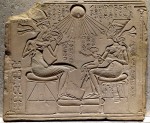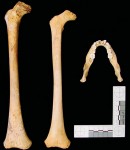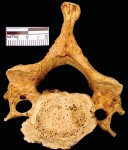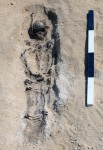 Pharaoh Akhenaten, husband of Nefertiti, father of Tutankhamun, upended Egyptian society when he repudiated the traditional gods and established the monotheistic cult of the sun god Aten. In the fifth year of his 17-year reign (1349–1332 B.C.), Akhenaten began construction on a new city on the east bank of the Nile 200 miles south of Cairo and 250 miles north of Luxor, dedicated to the worship of Aten. The pharaoh wanted to start afresh, build a new capital untainted by any memory of previous rulers and religion. Two years into construction Amarna was officially declared the capital and two years after that, construction was finished. In the space of these few years, Amarna would become a city with a population of 20,000-30,000, mostly officials, soldiers, laborers, servants who followed Akhenaten and the court.
Pharaoh Akhenaten, husband of Nefertiti, father of Tutankhamun, upended Egyptian society when he repudiated the traditional gods and established the monotheistic cult of the sun god Aten. In the fifth year of his 17-year reign (1349–1332 B.C.), Akhenaten began construction on a new city on the east bank of the Nile 200 miles south of Cairo and 250 miles north of Luxor, dedicated to the worship of Aten. The pharaoh wanted to start afresh, build a new capital untainted by any memory of previous rulers and religion. Two years into construction Amarna was officially declared the capital and two years after that, construction was finished. In the space of these few years, Amarna would become a city with a population of 20,000-30,000, mostly officials, soldiers, laborers, servants who followed Akhenaten and the court.
It was abandoned a few years after Akhenaten’s death until it was resettled in the Roman era. A thousand years without human habitation converts into archaeological gold, and because Amarna was built so quickly according to a plan by resident laborers during a time of social upheaval, it provides a unique window into life under Akhenaten. The cemeteries are particularly interesting because there’s no doubt about when and where the deceased lived, an advantage not often encountered in Egypt since cemeteries were usually separate from the towns of the living.
 Since 2005, the Amarna Project team has been exploring the South Tombs Cemetery where the 90% of the population that was not wealthy was buried. Archaeologists found evidence that the standard of living for the vast majority of people in Amarna was not only far from the idyll depicted on tomb walls, but also below the basic threshold you’d expect to find in the capital of a wealthy empire.
Since 2005, the Amarna Project team has been exploring the South Tombs Cemetery where the 90% of the population that was not wealthy was buried. Archaeologists found evidence that the standard of living for the vast majority of people in Amarna was not only far from the idyll depicted on tomb walls, but also below the basic threshold you’d expect to find in the capital of a wealthy empire.
The graves are simple, oblong pits marked by limestone boulder cairns with the occasional memorial stela or miniature limestone pyramid on top. Grave goods are similarly sparse. There’s a smattering of pottery, amulets, jewelry, cosmetics containers, but most of the graves include only human remains and the burial container. Out of the 200 graves excavated so far,  only 20 wooden coffins have been discovered. Everyone else was wrapped in a textile and rolled in mats made of rigid plant material. Even the coffins are downmarket. Most of them are plain undecorated boxes. Some are human shaped and decorated with funerary scenes. One of those is painted with hieroglyphics that don’t mean anything; they’re gibberish, probably copied by an illiterate artist for an illiterate customer.
only 20 wooden coffins have been discovered. Everyone else was wrapped in a textile and rolled in mats made of rigid plant material. Even the coffins are downmarket. Most of them are plain undecorated boxes. Some are human shaped and decorated with funerary scenes. One of those is painted with hieroglyphics that don’t mean anything; they’re gibberish, probably copied by an illiterate artist for an illiterate customer.
The bones themselves tell the most articulate story.
Researchers examining skeletons in the commoners’ cemetery in Amarna have discovered that many of the city’s children were malnourished and stunted. Adults show signs of backbreaking work, including high levels of injuries associated with accidents.
“We have evidence of the most stressed and disease-ridden of the ancient skeletons of Egypt that have been reported to date,” said University of Arkansas bioarchaeologist Jerome Rose (a National Geographic Committee for Research and Exploration grantee), one of the team of experts examining the dead. “Amarna is the capital city of the Egyptian empire. There should be plenty of food . . . Something seems to be amiss.”
 Analysis of the 159 individuals with at least 50% of the skeleton remaining revealed exceptionally high rates of nutritional deficiencies and workplace injuries. Cribra orbitalia (cranial lesions caused by malnutrition that appear in the upper orbits of the eyes) appear in 42.7% of the skeletons, porotic hyperostosis (lesions in the cranial vaults) in 2.9%, scurvy in 5.2%. Adults are shorter than ones from comparable sites. Child skeletons show significantly delayed growth starting from the age of just 7.5 months. The worst example showed a delay of two years, poor kid.
Analysis of the 159 individuals with at least 50% of the skeleton remaining revealed exceptionally high rates of nutritional deficiencies and workplace injuries. Cribra orbitalia (cranial lesions caused by malnutrition that appear in the upper orbits of the eyes) appear in 42.7% of the skeletons, porotic hyperostosis (lesions in the cranial vaults) in 2.9%, scurvy in 5.2%. Adults are shorter than ones from comparable sites. Child skeletons show significantly delayed growth starting from the age of just 7.5 months. The worst example showed a delay of two years, poor kid.
 They may have been small and poorly fed, but they were worked like the mule. The 95 adult skeletons in the sample are riddled with degenerative joint disease (DJD), musculo-skeletal stress markers (MSM) and healed bone fractures. From the study:
They may have been small and poorly fed, but they were worked like the mule. The 95 adult skeletons in the sample are riddled with degenerative joint disease (DJD), musculo-skeletal stress markers (MSM) and healed bone fractures. From the study:
A total of 71 adults (77.2 per cent) exhibited some evidence of DJD in at least one joint. The joints considered include the shoulder, elbow, wrist, hip, knee, ankle and all three regions of the spine. More than half of the individuals exhibiting DJD had severe manifestation (42/71; 59.2 per cent) in at least one joint. At the population level, a lower frequency of individuals exhibited DJD of the lower limb (47.7 per cent), but in contrast to the upper limb, the DJD of the lower limb was more often severe (21.6 per cent). Upper limb DJD was nearly ubiquitous among the South Tombs Cemetery population (65.9 per cent), but it was less often severe (13.7 per cent). The spine also exhibited high frequencies of DJD development (56.7 per cent presence; 35.6 per cent severe), with the most common severe manifestation being observed in the lumbar region
All that hurried construction work required to build Amarna from the desert up in four years is the probable cause. The standard-size limestone block measured 20 inches by 10 inches and weighed 154 pounds. These could be carried by one person, unlike the larger blocks of earlier periods, but not without major damage to the bones and joints, especially of the lower body.
 If there’s any consolation it’s that the small children were not subjected to this kind of work. Their malnourished little bodies showed no signs of DJD, MSM or trauma. They didn’t escape it for long, though. Two teenagers have injuries, one spondololysis (when the arch or back of the vertebra separates from the main body) and the other a fractured foot bone, which are likely to have been work-related.
If there’s any consolation it’s that the small children were not subjected to this kind of work. Their malnourished little bodies showed no signs of DJD, MSM or trauma. They didn’t escape it for long, though. Two teenagers have injuries, one spondololysis (when the arch or back of the vertebra separates from the main body) and the other a fractured foot bone, which are likely to have been work-related.
The temples of the old gods owned a good portion of the arable land. So it is possible that they were not “sharing” with Atenists. Also, if the population grew that fast, the area was not likely equipped to handle a population that large. Those both could have been contributing factors.
Is there any information about the quantity of grave goods in the richer population? Just wondering if the monotheistic religion differed from that of the polytheistic one when it came to burials and funeral rites.
This is a great post. I would just clarify that the capital was originally called “Akhetaten” (“Horizon of the Aten”). “Amarna” was not itself declared as the name for the capital back then. The modern name for this site, Tell el-Amarna, accounts for the modern name for this period in ancient Egyptian history.
Destroying Akhenaten was probably the reason for the bad condition of bodies found.someone had to tear it down,so unskilled Labor.christiand always point the finger at Akhenaten , ignoring the tens of millions killed by them.worship God on the light of the sun or perish by Lord God